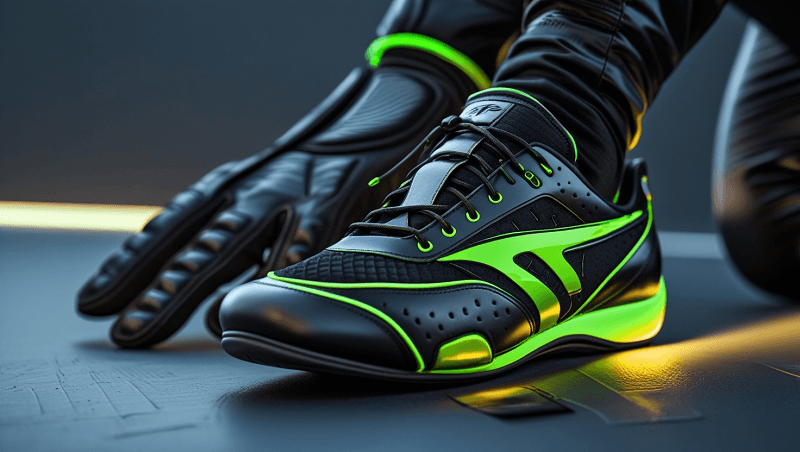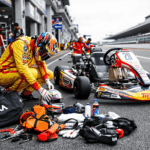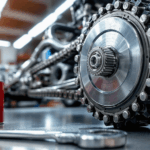As a dedicated go-kart racer for over a decade, I’ve learned that success on the track isn’t just about driving skills or having the fastest kart. The longevity of your racing gear—especially your gloves and shoes—can significantly impact both your performance and your wallet. Let me share how proper glove and shoe maintenance has saved me hundreds of dollars and enhanced my racing experience over the years.
Why Glove and Shoe Maintenance Matters in Go-Karting
Last summer, I watched a fellow racer toss his three-week-old racing gloves into the trash after they’d split at the seams mid-race. That $80 investment could have lasted months longer with proper care. When it comes to go-kart racing safety equipment, maintaining your gear isn’t just economical—it’s essential for consistent performance and protection.
Racing gloves and shoes are your direct connection to the kart. They protect your hands and feet while providing the tactile feedback needed for precise control. When they deteriorate, both your safety and performance suffer.
Signs Your Go-Kart Gloves Need Attention
Before diving into maintenance techniques, let’s identify when your gloves need some TLC:
- Fraying seams – Early warning sign of impending failure
- Thinning palms – Reduced protection and grip
- Stiffening material – Decreased dexterity and comfort
- Lingering odor – Bacterial growth that can degrade materials
- Discoloration – Material breakdown from sweat and oil
- Loose stitching – Structural weakness that will worsen quickly
Essential Go-Kart Glove Maintenance Routine
1. Regular Cleaning Protocol
My weekly glove maintenance routine has extended the life of my racing gloves by at least 50%:
- Hand wash only – Machine washing damages specialty materials
- Use mild soap – Harsh detergents break down protective coatings
- Lukewarm water – Hot water can shrink and warp materials
- Gentle agitation – Focus on soiled areas without scrubbing aggressively
- Thorough rinsing – Soap residue can irritate skin and degrade materials
- Air dry naturally – Never use direct heat sources like dryers or heaters
2. Proper Drying Techniques
After a sweaty race day, proper drying prevents odor and material breakdown:
- Reshape while damp – Helps maintain proper fit
- Dry flat or hang properly – Prevents misshaping
- Avoid direct sunlight – UV rays degrade synthetic materials
- Ensure complete drying – Moisture leads to mildew and material breakdown
- Use cedar blocks – Absorbs moisture and prevents odors naturally
3. Storage Solutions for Longevity
How you store your gloves between race weekends matters tremendously:
- Store in breathable bags – Never in plastic which traps moisture
- Keep in temperature-controlled environments – Extreme heat or cold damages materials
- Use glove inserts or stuffing – Helps maintain shape
- Separate from other gear – Prevents unnecessary compression or damage
- Avoid damp environments – Garages and trunks can promote mildew growth
Extending the Life of Your Go-Kart Racing Shoes
Racing shoes take a tremendous beating on the pedals. After ruining two pairs in my first season by neglecting proper care, I developed this maintenance system:
1. Cleaning Racing Shoes Effectively
Racing shoes require specific cleaning approaches based on their materials:
For Leather Components:
- Wipe with damp cloth after each use
- Use leather-specific cleaners monthly
- Apply leather conditioner quarterly
- Remove dirt from seams with soft brushes
- Clean eyelets and lace areas with cotton swabs
For Synthetic Components:
- Spot clean with mild soap solution
- Avoid submerging completely
- Use specialized sport shoe cleaners
- Clean rubber soles with baking soda paste for stubborn marks
- Treat with fabric protector spray after cleaning
2. Addressing Odor Issues
Nothing ruins racing gear faster than persistent odor, which indicates bacterial growth that degrades materials:
| Odor Prevention Method | Application Frequency | Effectiveness |
|---|---|---|
| Cedar shoe trees | Between uses | ★★★★★ |
| Baking soda | Weekly | ★★★★☆ |
| Charcoal inserts | Monthly replacement | ★★★★☆ |
| Freezing overnight | Monthly | ★★★☆☆ |
| UV shoe sanitizers | Weekly | ★★★★★ |
| Essential oil sprays | After each use | ★★☆☆☆ |
3. Repairing Minor Damage
Catching damage early can extend your shoe’s lifespan significantly:
- Sole separation – Apply shoe repair adhesive immediately
- Fraying laces – Replace before they break
- Worn heel cups – Reinforce with heel grips
- Insole compression – Replace with quality racing insoles
- Scuffed leather – Treat with leather restorer
Specialized Maintenance for Different Racing Conditions
Your maintenance routine should adapt to racing conditions. After learning this the hard way during my first wet race season, I now adjust my approach based on conditions:
Wet Weather Racing Gear Maintenance
When go-karting in wet weather, your gloves and shoes face unique challenges:
- Immediate drying – Don’t let wet gear sit in your bag
- Newspaper stuffing – Absorbs internal moisture
- Silicone spray – Apply to seams after drying (not before!)
- Salt removal – Wipe down with white vinegar solution if exposed to road salt
- Extra conditioning – Leather needs additional care after water exposure
Hot Weather Racing Challenges
Summer racing creates different maintenance needs:
- More frequent cleaning – Sweat contains salts that damage materials
- UV protectant – Apply to prevent sun damage
- Ventilation focus – Ensure complete drying between races
- Antibacterial treatment – Higher temperatures mean more bacterial growth
- Rotation system – Use multiple pairs to allow complete drying
Creating a Race Day Maintenance Kit
I never head to the track without my maintenance kit. This simple investment has saved countless pieces of gear:
Essential Race Day Maintenance Kit:
- Microfiber cloths
- Mild soap in travel container
- Leather wipes
- Spare laces
- Small brush for debris removal
- Shoe/glove deodorizer spray
- Emergency repair tape
- Small sewing kit
- Leather conditioner wipes
- Waterproofing spray
Understanding Material-Specific Maintenance
Different materials require different care approaches. When selecting what to wear go-kart racing, consider maintenance requirements:
Leather Racing Gloves and Shoes
- Pros: Durability, excellent feel, molds to hand/foot
- Cons: Requires regular conditioning, vulnerable to water damage
- Maintenance Focus: Conditioning, waterproofing, proper drying
Synthetic Racing Gloves and Shoes
- Pros: Water-resistant, consistent feel, often cheaper
- Cons: Can retain odors, may wear through faster at stress points
- Maintenance Focus: Odor prevention, seam reinforcement, UV protection
Hybrid Material Racing Gear
- Pros: Combines benefits of multiple materials
- Cons: Different sections may age differently
- Maintenance Focus: Identifying appropriate care for each component
The Economics of Proper Glove and Shoe Maintenance
Let’s talk numbers. Quality racing gloves typically cost $80-150, while good racing shoes range from $150-300. With proper maintenance:
- Without maintenance: Average lifespan of 3-6 months with regular use
- With basic maintenance: Lifespan extends to 9-12 months
- With comprehensive care: Can last 18+ months
For a racer competing twice monthly, this represents potential savings of $300-600 annually just on gloves and shoes. That’s money better spent on making your go-kart faster or other performance upgrades!
Recognizing When Replacement Is Necessary
Even with perfect maintenance, racing gear eventually needs replacement. Safety should always trump economy. Replace your gloves when:
- Seams have failed or are significantly weakened
- Palm material has worn through or thinned significantly
- Fit has become loose due to material stretching
- Closure systems no longer secure properly
- Inner lining is separating from outer material
Replace shoes when:
- Sole grip pattern has worn smooth
- Internal cushioning has compressed permanently
- Ankle support has weakened
- Closure systems fail to secure properly
- Water/moisture penetrates easily
Sustainable Practices for Racing Gear
As racers, we should consider the environmental impact of our gear. When your gloves or shoes have reached the end of their racing life:
- Repurpose for practice sessions – Save your best gear for race days
- Donate to karting schools – Many accept used gear for beginners
- Recycle components – Many parts can be recycled separately
- Use as garage rags – Old gloves make excellent cleaning cloths
- Proper disposal – Research how to dispose of synthetic materials properly
Conclusion
Proper glove and shoe maintenance isn’t just about saving money—it’s about consistency in performance. Well-maintained gear provides consistent feel and feedback lap after lap, race after race. This consistency translates directly to better driving and more predictable handling.
I’ve seen too many racers blame their kart setup for issues that were actually caused by worn-out gloves or shoes affecting their feel and control. When maintaining your go-kart, don’t forget that your personal gear is just as important as any mechanical component.
Implement these maintenance practices, and you’ll not only save money but also enjoy more consistent performance every time you hit the track. Your hands and feet are your connection to the kart—treat the gear that protects them with the same care you give to your engine or chassis.

Goran, an experienced go-kart racer, fuels GoKartLife.com with his passion and expertise. He offers valuable insights and tips for fellow enthusiasts, fostering the growth of the go-kart community. Join Goran at GoKartLife.com and immerse yourself in this exhilarating sport.
Last modified: April 27, 2025



